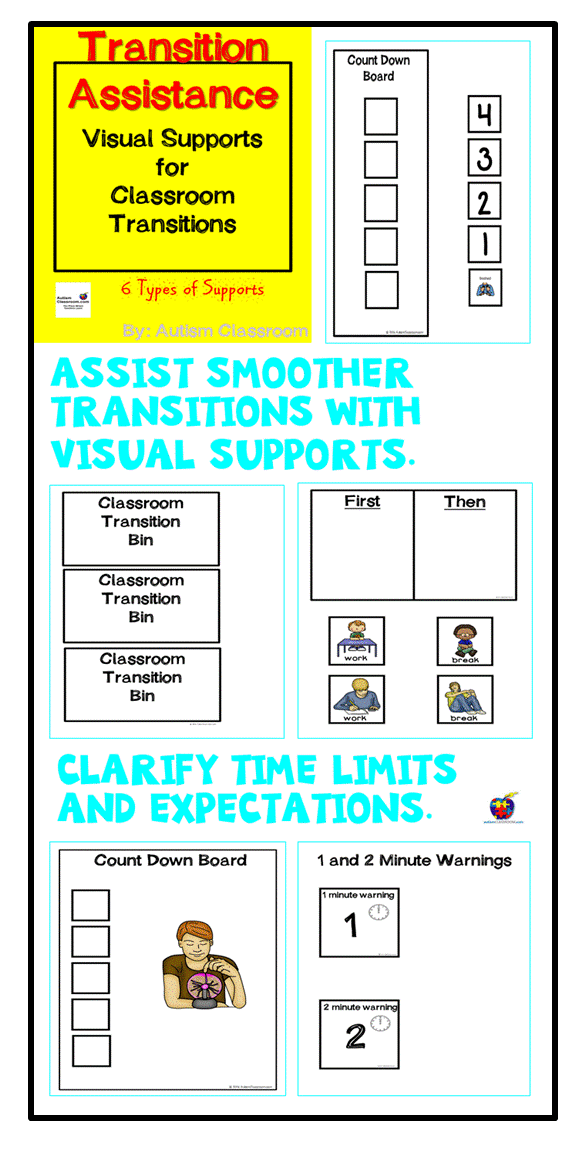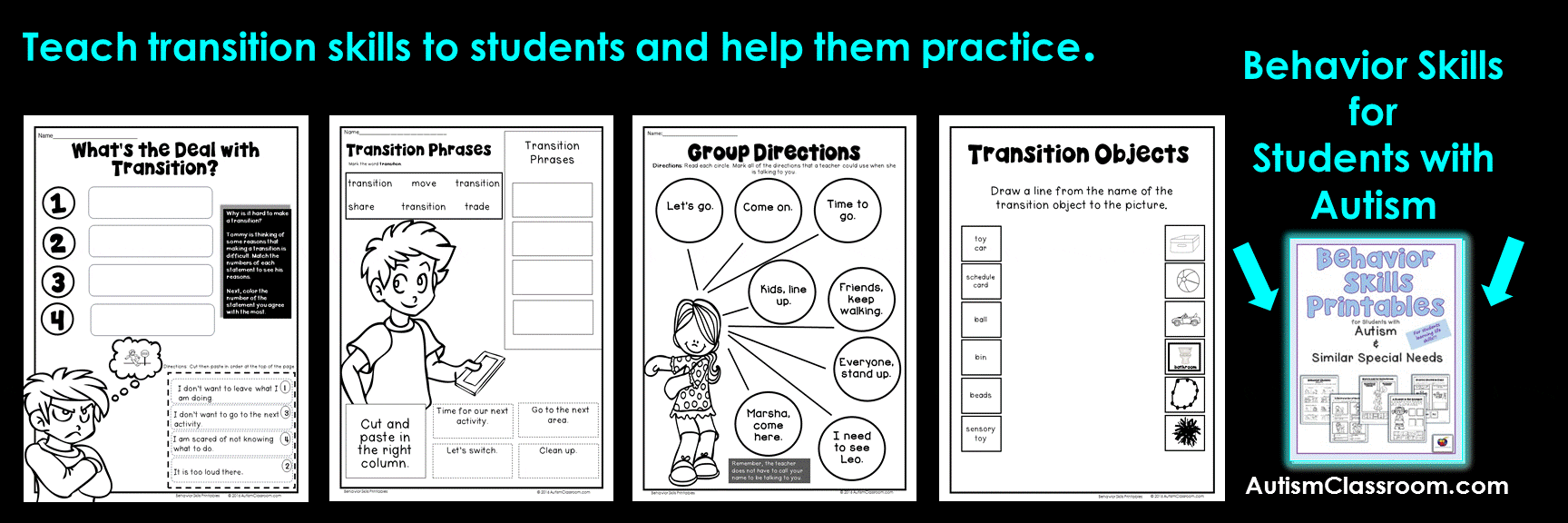
Transitions are difficult for many students on the autism spectrum. When a child with autism transitions, it can sometimes cause a challenge. Teachers and caregivers can attempt to ease transitions in a number of ways. Clarifying time limits, using timers and clearly showing expectations can help. Eloping in autism can be present as well. Behavior intervention strategies for elopment are even harder to find. Which is why in some cases, even more is needed. Many times visual supports offer an additional source of input that can be beneficial to students. In addition to visual supports, using words to provide reassurance, preparing students for transitions and utilizing objects can ease challenges. If you find that you need to support students in the area of transitioning from activity to activity, try some of these ideas.
VISUALS
Use visual supports do the talking for you. Visual supports can take many forms. For example, pictures icons, photos, written words or environmental cues can be considered visual supports. First, you can start by showing a topic board with pictures of various activities that will occur during the lesson. Be sure to include an indication of when the lesson or activity will be over.

Another way visual supports can be used to aid transitions is to a make a simple contract with a “First, Then” board. The “First, Then” board can be used to show the non-preferred item first, then a preferred item. The student would see that first one activity happens, then the second, typically more preferred activity, happens after that. Sometimes, just seeing that the activity will happen makes it more concrete.

A third way to use visual supports is to clarify the ending of an activity using a visual count-down board. Teachers and caregivers can use a visual count-down board to show the student that an activity is coming to an end. Take each icon off of the board one at a time at various times to prepare the student for the end of an activity. The count-down can be arbitrary and does not have to follow any specific time line. It is simply a visual representation of the activity coming to an end.
WORDS AND REASSURANCE
You cannot underestimate the power of using reassuring words for kids. Transitions are difficult for students on the autism spectrum for a number of reasons.

No matter what the reason, sharing with students that things will be "ok" will help when the child with autism transitions. Teachers could start by giving the student a verbal 1-minute warning every time any activity is almost finished. The warning can be given by simply saying, “We have one more minute.” This needs to be paired with a visual cue such as picture icon with an image and words that say “one minute.”
A second strategy to consider is to use words to give choices. Think of ways to invite choice making into the transition. For example, “Do you want to walk to the next center or do you want to skip?”, “Which crayon color do you want to use when you get to the writing center?” or “Do you want to complete your work with a marker or a pencil?” are all ways to incorporate student choice. Teachers and caregivers could also reassure students that a fun activity will occur after the more difficult, less-preferred activity. The fun, more-preferred activity can be something quick and does not have to be a long drawn-out activity. Some students work at a slower pace than others. For them, the transition creates anxiety related to not finishing what they started or not being allowed to come back to a fun activity. They need reassurance that they can stop an activity and come back later. For those students who might think that once the activity ends, they can never get back to it, your words and reassurance that they can come back to it later, can help.
PREPARATION
Preparing for transitions is critical. Clarify time limits and expectations ahead of time using schedules and visual directions. Use a poster to remind the adults in the classroom to clarify every transition. This can be done by always using simple concrete language (very few words) to prepare the student for the transition. For example, use a phrase similar to this after every activity: “Reading is finished. (Pause.) Time for Math.”
Teachers can also prepare students for transitions by using direct instruction. Consider teaching them the skills they need through worksheets, role playing and practice.
Be prepared by having a topic board in each activity area for the student to communicate his or her wants and needs. If you have a student who is an eloper and who will attempt to dart away, be sure to guide the student to the next activity. Get in close proximity of the student before you make the request for them to transition so that you will decrease their opportunity to run to the wrong area.
OBJECTS
Objects help a great deal when making transitions smoother. Let the student carry something or “help” you to the next activity (schedule cards, picture icons, or the materials for the lesson may work well) and establish what this item will be before the moment arrives. Teachers should also consider providing access to preferred items during transitions. Another idea using objects would be to help students tolerate unfavorable activities with the help of a transition bin. Before the next activity begins, try using a transition box or backpack with preferred items that the student likes. This box or backpack should be visible to the student before he or she comes to that area to work. Seeing the box of items may motivate the student to transition to that area. Additionally, if needed, let the student hold something when they are sitting at the activity. Develop a systematic plan to fade the object they are holding. For example, at first, allow them to hold it during the lesson, then have them place it down on the desk when they need to answer, next have them place it down during the lesson, eventually, give the student access to the item for 2 minutes after the lesson.

There you have it, a few strategies that can be used to make transitions a little easier for students. It is hard to find behavior intervention strategies for elopement. Autism and transition are certainly a needed topic in schools today. If you are looking for more information, the resource Transition Assistance Visual Supports for Classroom Transitions is available in my store. If you have any more questions regarding my supports for transitions or behavior skills, contact me at

Autism Classroom has materials for teaching social skills and other resources for Special Education & General Education settings. Many items are for students with developmental delays as well. Materials are designed for early elementary, special education & for teens with autism. This store takes pride in providing products to help set up & organize Special Education classrooms and home environments for educators and families.





